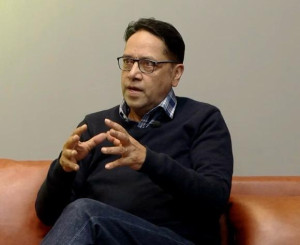Books
A trailblazer’s tale of service and progress
Mahabir Pun’s autobiography covers his advocacy for education and rural development in Nepal, to his pioneering efforts in bridging the digital divide through the establishment of wireless networks.
Khim Lal Devkota
Mahabir Pun is currently traveling across different districts, promoting his book and raising funds for the Agricultural Inputs Company Limited (AICL) in Birgunj. During my time as a member of the National Assembly, I raised questions about why he was compelled to undertake such extensive travel.
I emphasised the need for the state to recognise and support individuals of Pun’s calibre—individuals who are humble, qualified, capable and experienced. It is crucial to provide him with the necessary environment to continue his research work and assist in creating essential infrastructures. I argued that individuals like Pun should be given priority in the National Assembly due to their significant contributions to various sectors in the country.
If the government has indeed granted permission for Pun to manage the AICL, it must fulfill its obligations as per the agreement. Failure to do so raises serious questions about the government’s intentions and the necessity of such arrangements.
At the time of my address in Parliament, I had not yet read Pun’s autobiography, ‘Mahabir Pun: Samjhana, Sapana Ra Abiral Yatra’ (Mahabir Pun: Memories, Dreams, and Endless Journeys). My comments were based on assumptions drawn from media reports. However, having now read his book, I hold him in high esteem and admiration; he exemplifies true patriotism and deserves recognition. As I previously suggested that the National Assembly should emulate individuals like him, I maintain that if there were anyone deserving of a position above the National Assembly, it would undoubtedly be Pun.
This book was published in October 2023 by the National Innovation Center, an organisation he founded. It is highly likely that, apart from academic textbooks, this book will become one of Nepal’s best-selling books.
The book is divided into 18 sections, each focusing on specific milestones and themes in Pun’s journey. These include his early steps and key transitions, such as moving from high school to college and nurturing his aspiration to become a teacher. It also delves into a significant turning point fuelled by indignation, followed by a transformative four-year stay in the United States. The narrative then spans two decades of immersion in rural villages, detailing the experiences and insights gained during this time.
Pun’s efforts to expand wireless networks and internet connectivity in remote areas are chronicled, alongside a list of accolades and honours he has received. Moreover, the book highlights his initiatives towards rural tourism development, culminating in the establishment of the National Innovation Centre. Lastly, readers are offered glimpses into Pun’s personal life and family dynamics.
The book’s captivating narrative makes it akin to a novel, ensuring that readers remain engaged until the very end. I swapped my regular newspaper reading time in the morning to reading the book for a couple days until I finished it.
Pun was born in 1955 in Nangi Village, part of the Annapurna Rural Municipality in the Myagdi District of the Gandaki Province. An interesting aspect of his family history is that his father served as a soldier in the British army in the former British colony of Malaya (now Malaysia). His father recognised the importance of education for his children, which influenced Pun’s upbringing significantly.
During that time, there was a prevailing belief and practice that to serve in the Indian or British army, one needed to have at least a 5th-grade education. Despite the possibility of a military career, Pun’s father prioritised his son’s education. Pun received schooling in various villages, and around 1968, his father took him to Khairhani High School in Chitwan after a week-long journey on foot, enrolling him in the Ninth grade.
The journey to Chitwan, the search for relatives to facilitate his education from Myagdi, and residing with his maternal uncle in Chitwan marked significant milestones in Pun’s life. Around 1970, he completed his secondary education—SLC (now SEE)—with second division and was then brought to Kathmandu by his father to pursue further studies. His father provided unwavering support and inspiration for Pun to do well in his studies.
In 1971, he enrolled in intermediate in science (ISC, now higher secondary in science) at Amrit Science Campus and passed with second division. Although his dream of studying engineering abroad on a scholarship remained unfulfilled, he returned to Chitwan as a teacher. He reveals in the book that his first monthly salary as a teacher in 1973 was Rs225.
He served as a teacher for 13 years before departing from his school due to a dispute with the chief district officer (CDO). After leaving the school, he returned to Kathmandu and lived as a wanderer for a time, eventually residing in an American library. At the age of 31, he pursued further studies in the United States of America. The book also includes a letter written to Neil Armstrong, the first American astronaut to set foot on the moon, seeking a scholarship, and a reply received from his secretariat. Upon returning to Nepal after four years, the book meticulously details the ups and downs of the 20 years spent in his native villages of the Myagdi district.
The book tells the simple story of a man who finds himself stuck in various jobs. Pun mentions that he was greatly influenced by the famous French novel ‘Around the World in Eighty Days’ by the French writer Jules Verne. Like the main character of that novel, he writes that being stubborn and self-confident inspires one another to move forward.
The book offers a comprehensive account of the author’s significant contributions to school reform and socio-economic transformation during his time in the villages. A key focus is on the establishment of a wireless network and the expansion of internet access in remote areas, which gained international recognition.
Notably, the BBC covered Pun’s efforts on October 22, 2001, highlighting his pioneering work in bringing digital connectivity to the mountain village of Nangi through Himanchal High School. This global exposure garnered support from individuals worldwide, prompting even a British parliamentarian to raise concerns about internet accessibility in Scotland compared to the Himalayan regions of Nepal. However, the book also sheds light on the surprising lack of recognition for the author’s achievements in Kathmandu.
Additionally, the book details the numerous awards and accolades Pun has received, including the prestigious Ramon Magsaysay Award in 2007. Despite his continued dedication to social service through the National Innovation Center, the book criticises the government’s approach to research and highlights repeated failures in securing assistance.
The narrative includes anecdotes ranging from Pun’s childhood in Nangi, Myagdi district, to his experiences in Nebraska, US. From memories of tending sheep to encountering sweet tea for the first time, the book recounts various personal moments. It also documents Pun’s efforts to join the army, pursue scholarships in the US, and engage with government officials, including the prime minister, regarding research and innovation.
Pun vividly portrays the society, thoughts, and environment of his time through his story. His dedication to teaching, scientific pursuits, social work and rural development is evident throughout the book. Despite his achievements, Pun’s humble personality shines through, leaving a lasting impression on readers. He is revered as a Nepali teacher, young scientist, inventor and social activist worldwide.
In Pun’s narrative, there is a profound concern for Nepal’s development and an exploration of the reasons behind the country’s lagging progress. The book delves into development stories from countries like Singapore, Korea, Israel, Malaysia and China, highlighting their commitment to research, innovation, and progress. Similarly, it discusses Nepal’s historical economic challenges and the need for innovation and dedication to overcome them.
Mahabir Pun: Samjhana, Sapana Ra Abiral Yatra
Author: Mahabir Pun
Year: 2023
Publisher: National Innovation Centre




 16.12°C Kathmandu
16.12°C Kathmandu









%20(1).jpg&w=300&height=200)

